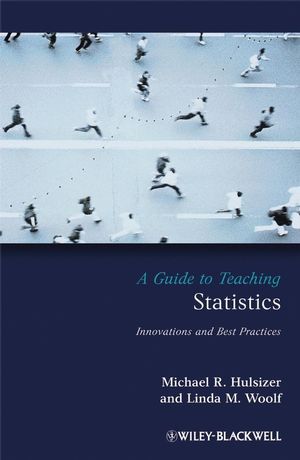|
Textbook
A Guide to Teaching Statistics: Innovations and Best PracticesISBN: 978-1-4051-5574-8
Paperback
280 pages
October 2008, ©2008, Wiley-Blackwell
 Other Available Formats: Hardcover
|
||||||
Series Editors’ Preface xiii
Preface xvii
Part I Course Preparation 1
1 Teaching Statistics: A Beginning 3
So Why Teach Statistics? 5
Historical Pedagogical Controversies 7
Who should teach statistics? 7
Statistics labs and related technology 8
Content of statistics courses 10
Statistics in Relation to the Discipline 11
Sequence of the Class and Topics 12
Introducing Research Methods within the Context of Statistics 16
Student Populations 17
Mathematical ability 17
Cognitive ability and learning styles 19
Self-efficacy and motivation 20
Gender 22
Helping Your Students Survive Statistics 23
Conclusion 25
2 Nuts and Bolts of Teaching Statistics 27
Syllabus Construction 28
Textbook Selection 30
Conceptual orientation 31
Level of difficulty 33
Chapter topics and organization 34
Core formulas and vocabulary 35
Type of data sets/quality of the exercises 36
Traditional Versus Electronic Textbooks 37
Supplemental Materials 38
Study guides 39
Companion Web sites 39
Computer tutorials 40
Electronic Discussion Boards 42
Multimedia Tools 44
Presentation technology 45
Interactive applications: Java applets, Flash, Shockwave, and HTML 46
Multimedia simulation programs 48
Conclusion 49
Part II Theoretical and Pedagogical Concerns 51
3 Educational Reform in Statistics 53
Educational Reform 54
Statistically Educated Students 56
Statistical Literacy 59
Knowledge elements 60
Dispositional elements 62
Statistical Thinking 63
Statistical Reasoning 66
Misconceptions Impacting the Development of Literacy, Thinking, and Reasoning 70
Final Thoughts on Statistical Literacy, Thinking, and Reasoning 72
Assessment 73
What is the role of assessment? 73
What is the role of authentic assessment? 74
Assessment and learning outcomes or goals 75
Conclusion 77
4 In the Classroom 79
Conceptual Learning, Active Learning, and Real Data 80
Conceptual learning versus rote memorization 80
Active learning 82
Real data 83
Instructional Techniques 84
Lecture 85
The use of questions 86
Practice problems and examples 87
Journal assignments 88
Activities and demonstrations 89
Writing assignments 90
Concept maps 93
Cooperative learning 94
Projects 95
Assessment 97
Principles of effective assessment 97
Mastery learning 98
Confronting Fear and Anxiety 99
Conclusion 101
Part III Teaching Specific Statistical Concepts 103
5 Descriptive Statistics and Bivariate Distributions 105
Graphing Data 106
The use of graphs in science 107
Elements of good design 108
Human graphical perception 109
Available graphing methods 110
Software design 111
Normal Distribution 112
Measures of Central Tendency 114
Measures of Variability 117
Correlation 119
Simple Linear Regression 122
Computer Applications 125
Conclusion 127
6 Teaching Hypothesis Testing 129
Samples, Sampling Distributions, and the Central Limit Theorem 131
Confidence Intervals 133
Introduction to Null Hypothesis Testing 135
Additional Introduction to Hypothesis Testing Concepts 138
Power 138
Effect sizes 140
Type I and Type II errors 141
Analysis of Variance 142
Introduction to ANOVA 142
Violating ANOVA assumptions 143
Factorial ANOVA 144
General linear model 145
The Debate Surrounding Null Hypothesis Significance Testing 146
Nonparametric Statistics 146
Computer Applications 149
Conclusion 151
Part IV Advanced Topics and Approaches 153
7 Data Analysis in Statistical Education 155
Teaching with Statistical Software Tools 156
Data Analysis Packages 158
SPSS 158
Microsoft Excel 160
Other commercial data analysis programs 162
Comparing data analysis programs 163
Data Analysis Software Textbooks 165
Using Data Sets in the Classroom 166
Artificial data sets for the classroom 167
Reality-based data sets 168
Finding appropriate reality-based data sets 169
Drawbacks to using real data sets 174
Conclusion 176
8 Endings and Beginnings 179
Multivariate Statistics 180
Multiple regression 182
Logistic regression 184
Additional multivariate techniques 185
Special Topics 186
Ethics 187
Diversity 190
Online Statistical Education 193
Finishing up Any Statistics Course 195
Final Thoughts 198
References 201
Index 248



